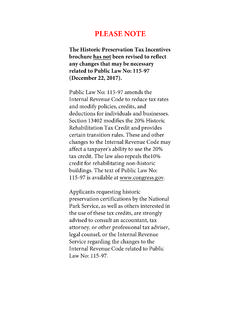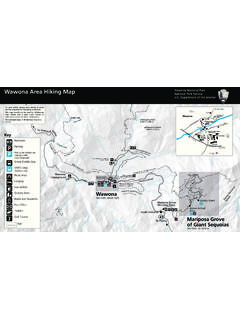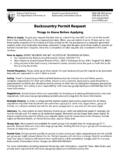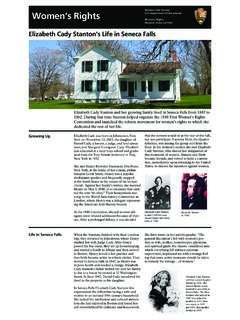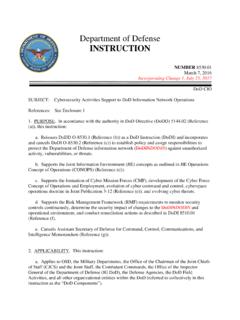Transcription of National Historic Preservation Act, Section 106 - NPS
1 Quick Guide for Preserving Native American Cultural Resources National Historic Preservation Act, Section 106 Draft 2012 Page | 1 National Historic Preservation Act, Section 106 A Quick Guide for Preserving Native American Cultural Resources What is Section 106? Section 106 is the portion of the National Historic Preservation Act (NHPA) that is concerned with Federal undertakings. What is a Federal undertaking? A Federal undertaking is a project, activity, or program either funded, permitted, licensed, or approved by a Federal Agency. Undertakings may take place either on or off federally controlled property and include new and continuing projects, activities, or programs and any of their elements not previously considered under Section 106. What does Section 106 require? Section 106 requires Federal agencies to take into account the effects of their undertakings on Historic properties and to provide the Advisory Council on Historic Preservation (ACHP) with a reasonable opportunity to comment.
2 In addition, Federal agencies are required to consult on the Section 106 process with State Historic Preservation Offices (SHPO), Tribal Historic Preservation Offices (THPO), Indian Tribes (to include Alaska Natives) [Tribes], and Native Hawaiian Organizations (NHO). What are Historic properties? Historic properties are any prehistoric or Historic districts, sites, buildings, structures, or objects that are eligible for or already listed in the National Register of Historic Places. Also included are any artifacts, records, and remains (surface or subsurface) that are related to and located within Historic properties and any properties of traditional religious and cultural importance to Tribes or NHOs. What role do THPOs, Tribes, and NHOs play in the Section 106 process? The Section 106 regulations (36 CFR 800) place particular emphasis on consultation with THPOs, Tribes, and NHOs.
3 Federal agencies must consult THPOs, Tribes, and NHOs about undertakings when they may affect Historic properties to which a Tribe or NHO attaches religious or cultural significance. This requirement applies regardless of the location of the Historic property. What if an Historic property is not listed in or has not been previously determined eligible for the National Register of Historic Places (NRHP)? If an Historic property is not listed in or has not previously been determined eligible for the NRHP then, as part of the Section 106 process, it should be evaluated by the Federal agency in consultation with the SHPO, THPO, Tribe, or NHO to determine if it meets NRHP eligibility. Steps for determining eligibility can be found in National Register Bulletin 15: How to Apply the National Register Criteria for Evaluation. If there are questions about the eligibility of an Historic property, the Federal agency overseeing the undertaking can seek a formal Determination of Eligibility (DOE) from the Keeper of the National Register (see 36 CFR 63).
4 The Keeper will then determine if the property is eligible for listing in the National Register of Historic Places. What regulations govern the Section 106 process? 36 CFR 800 (Protection of Historic Properties) governs the Section 106 process and outlines how Federal agencies are to consult with SHPOs, THPS, Tribes, NHOs, and other interested parties, identify Historic properties, determine whether and how such properties may be affected, and resolve adverse effects. For more information about the Section 106 compliance process visit the Advisory Council on Historic Preservation website at: For the 36 CFR 800 regulations and assistance in applying them go to: Quick Guide for Preserving Native American Cultural Resources National Historic Preservation Act, Section 106 Draft 2012 Page | 2 What is the process for Section 106 compliance? Identify Historic properties: determine scope of efforts, identify Historic properties, evaluate Historic significance and effects, consult with SHPO/THPO/ Tribe/NHO.
5 [see 36 CFR Part (b)] Section 106 process initiated by Federal Agency: establish undertaking, determine responsible Federal agency, identify appropriate SHPO, THPO, Tribe, NHO and other consulting parties to include the public, also notify and plan to involve the public. [see 36 CFR Part ] Resolve adverse effects: continue consultation among Federal agency, SHPO/THPO/Tribe/NHO, and consulting parties, avoid or mitigate adverse effects. [see 36 CFR Part ] If undertaking is a type of acivity that does not affect Historic properties then responsible Federal agency has no further obligations under Section 106. [see 36 CFR Part (b)] If no Historic properties have been identified or are affected, Federal agency provides documentation to SHPO/THPO and notifies consulting parties. Documentation is also made available to the public. SHPO/THPO and the Advisory Council on Historic Preservation have 30 days to object.
6 Lack of objection within 30 days means Federal agency has completed its Section 106 responsibilities. [see 36 CFR Part (d)(1)] If Federal agency finds Historic properties are not adversely affected, they notify and provide documentation to SHPO/THPO and consulting parties. SHPO/THPO have 30 days to review. Lack of objection by SHPO/THPO or consulting parties within 30 days means Federal agency may carry out the undertaking. Federal agency retains records of findings of "no adverse effect" and makes them available to the public. Failure of Federal agency to carry out the undertaking in accordance with the findings requires reopening of Section 106 process. [see 36 CFR Part (d)(1)] memorandum of agreement (MOA), project moves forward. An MOA is evidence of a Federal agency s compliance with Section 106. The agency is obligated to follow the terms of the MOA. Failure to do so requires the agency to reopen the Section 106 process.
7 [see 36 CFR Part (c)] After reviewing ACHP comments the Federal agency head decides if project: moves forward, stops persuant to mitigation, or steps back through the Section 106 process. Undertaking is type that might affect Historic properties? YES NO Historic properties are adversely affected? YES NO Failure to resolve adverse effects? YES NO Assess adverse effects: apply criteria of adverse effect. [see 36 CFR Part ] Historic properties have been identified or are affected? YES NO Advisory Council on Historic Preservation (ACHP) provides comments to head of Federal agency. ACHP comments must be considered when final agency decision on the undertaking is made. [see 36 CFR Part ]
